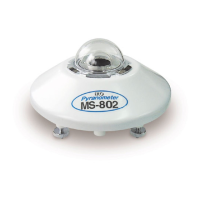EKO INSTRUMENTS CO., LTD. - Pyranometers MS-802/802F/402/402F/602 - Instruction Manual Ver.13
The recommended
(1)
sampling rate for pyranometers is smaller than τ. So, for EKO pyranometers, the
sampling rates that have to be programmed in the data logger systems should not exceed the values as
given in table 7.1.
Performing averaging and/or integration of measurement data can be meaningful to, e.g., reduce the
data volume or to meet application-specific requirement. Note that shorter sampling rates allow to use
shorter averaging/integration times (example for MS-802: 10 second sampling rate, 1 minute averaging
period). It could also be meaningful to store not only average values, but to keep track of all statistical
values during the averaging period, namely: average, integral, minimum and maximum values, and
standard deviation.
As a general recommendation, the averaging/integration period should be as short as possible, but long
enough to reduce the data volume to store the processed data safely.
(1)
“Guide to Meteorological Instruments and Methods of Observation”, WMO reference document Nr. 8.
Examples:
The total daily radiant energy in Joule per meter squared (J/m
2
) is obtained by integrating the solar
irradiance over time. To calculate the total daily radiant energy in Joule per meter square (J/m
2
), multiply
the averaged solar irradiance I [W/m
2
] by the averaging interval period (s). Then sum-up the total data
number (n) of averaged data points in one day. Its physical unit is expressed with [J/m
2
] and can be
calculated with J = W・S

